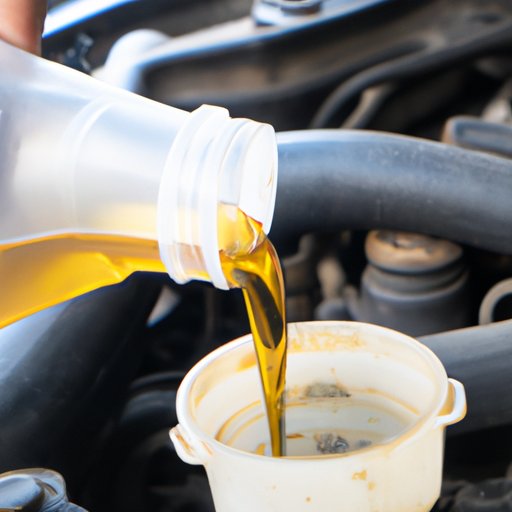
Introduction
Oil is essential for the proper functioning of your engine. It lubricates internal components, cleans the engine, and regulates its temperature. However, adding too much oil to your engine can cause significant damage. Overfilling oil usually happens when a vehicle owner mistakenly adds too much oil when changing it, topping it off between oil changes, or adding oil without checking the level properly.
Symptoms of Overfilled Oil
There are several symptoms that can indicate an overfilled oil problem. Some of the most common include:
Smoke coming from the exhaust
Overfilled oil can cause too much pressure to build up, which can release excess oil and smoke from the engine. Smoke caused by burning oil can be blue or white, and it can occur due to valve stem seals packing up, or oil control rings sticking as a result of too much moisture. Seeing smoke from your exhaust may also be indicative of a more serious problem, so seek professional help immediately.
Oil leaks from the gasket
An overfilled engine can cause oil to leak through gaskets and seals. The excess pressure can cause seals and gaskets to break down, causing oil leaks. Oil leaks can cause substantial collateral damage to other components, and if left unattended, can cause significant engine issues down the road.
Foamy oil on dipstick
Checking your oil dipstick can reveal whether there’s an overfilled oil problem. If there’s foam on the dipstick, that’s a clear sign of overfilled oil. The foam is caused by the overfilled crankcase aeration issue, where the moving of the piston causes excess oil to mix with air and whipped, thereby creating a bubbling look appearance on the dipstick.
Risks of Running an Engine with Overfilled Oil
Overfilling oil can drastically reduce an engine’s performance. At best, your engine may sound like it’s working harder to run, and, at worst, the engine may seize completely. The excess oil can also cause damage to internal components, including cylinder walls and bearings leading to expensive repairs.
Reduced Engine Performance
The performance of an engine with overfilled oil can be severely impacted. The additional pressure caused by the excess oil can cause the engine to run rough and feel sluggish, resulting in decreased gas mileage, and overheating issues. In some extreme cases, the engine may even stall. It’s critical to diagnose the problem as soon as you suspect an overfill issue to minimize damage risk.
Potential Damage to Internal Components (bearings, cylinder walls)
An overfilled oil situation can cause pressurization that can inhibit oil from lubricating internal parts. If the pressure gets too high in the oil pan, the seals or other engine components can become damaged. This can, in turn, cause engine components such as bearings and cylinder walls to fail and ultimately lead to an engine malfunction.
How to Fix Overfilled Oil
If you create an overfilled oil issue, there are two significant fixes that you can perform to resolve the issue:
Draining the excess oil
The most accessible fix is to drain the excess oil from the engine. To do this, locate the oil drain plug underneath your vehicle. Make sure the engine is not hot, then place a bowl under the drain plug and remove it to drain the excess oil. Ensure the correct oil level before starting the engine.
Taking the vehicle to a professional mechanic
If the overfilled oil caused significant damage to the engine, you may need to take your vehicle to a professional mechanic to get it fixed. They will be able to determine the full extent of the damage and suggest the proper course of action to repair the vehicle. It’s advisable to get this issue resolved as soon as possible to prevent further damage.
Tips for Checking Oil Level
Regularly checking your oil level and staying within the manufacturer’s recommendations is essential to maintain your car’s lifecycle. Some tips on checking oil level include:
Using a dipstick to check oil level
A dipstick is a tool provided in every car to check oil levels, ensuring the appropriate oil levels. Ensure the engine is turned off while using the dipstick, remove it and wipe down the dipstick with a towel. Reinsert the dipstick and check the level against the top and bottom indicators. Ensure that you are checking appropriate oil levels recommended by the vehicle manufacturer.
Checking the color and consistency of the oil
Checking oil color can help detect issues early. Fresh oil has a light amber color, while older oil can appear darker as it decomposes. The consistency should also be smooth. If there’s grittiness or a significant color change, then it might be an indication for oil replacement or potential damage to internal components and seek professional help.
Preventative Measures to Avoid Overfilling Oil
There are several preventative measures you can take to avoid overfilling your vehicle’s oil:
Regularly check oil levels
To avoid overfilling, it’s best to check the oil level regularly so that it falls within the recommended levels. This becomes even more critical if your vehicle has an oil burning issue, which many older vehicles may experience.
Use appropriate oil type recommended for the vehicle
Vehicles have different oil requirements, so it’s essential to use the correct type. You can check the owner’s manual, or the oil cap indications will help you identify the appropriate engine oil type to use. Never attempt to mix oil types as that can cause incompatible oil characteristics.
Conclusion
In conclusion, preventing an overfilled oil situation and checking your vehicle’s oil level can save you a lot of time, money and prevent damage to your engine. Checking your vehicle’s oil levels, using the appropriate oil, and getting regular checkups can go a long way in ensuring your vehicle operates at optimal levels.
By paying attention to your vehicle’s oil levels and seeking professional help in time, you can avoid costly damages and ultimately result in long term efficiency, reliability and prolong the lifespan of your vehicle’s engine.





